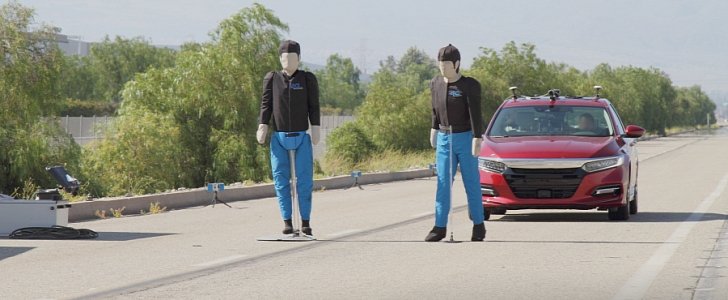With a headline like that, it’s also important to highlight that water is still wet. But jokes aside, a lot of drives don’t understand the limitations of pedestrian detection.
Automatic emergency braking is another example worth taking into consideration, and its performance varies widely from case to case. Turning the focus back on AEB with pedestrian detection, it shouldn’t come as a surprise this system is “completely ineffective at night.”
The AAA evaluated the performance of four sedans equipped with the life-saving technology, and testing was conducted in Fontana, California using adult-sized dummies in varied scenarios. Depending on the circumstances, pedestrian detection may fail to stop the car to a halt during daylight. This gets us to the warnings found in every owner’s manual, which clearly state that no safety system is better than a responsible driver in the real world.
“Pedestrian fatalities are on the rise, proving how important the safety impact of these systems could be when further developed,” explained Greg Brannon, director of Automotive Engineering and Industry Relations at the AAA. “Our research found that current systems are far from perfect and still require an engaged driver behind the wheel,” he concluded.
The time of day, location, and reaction time are obvious factors to pedestrian fatalities, but speed shouldn’t be ignored either. Braking from 50 miles per hour to a standstill is one thing, but try to calculate how long it takes for the car to stop from 80 or higher velocities. The AAA says that the risk of severe injuries or death is 47 percent at 30 miles per hour as opposed to 18 percent at 20 miles per hour, a 10-mph difference that… wait for it… could make the difference between life and death for the pedestrian.
Testing the four sedans has also revealed that the systems performed best when an adult crosses in front of a vehicle traveling at 20 miles per hour during the day. The success rate for avoiding a collision is 40 percent, and at speeds of 30 miles per hour, most systems failed to perform as intended.
The AAA evaluated the performance of four sedans equipped with the life-saving technology, and testing was conducted in Fontana, California using adult-sized dummies in varied scenarios. Depending on the circumstances, pedestrian detection may fail to stop the car to a halt during daylight. This gets us to the warnings found in every owner’s manual, which clearly state that no safety system is better than a responsible driver in the real world.
“Pedestrian fatalities are on the rise, proving how important the safety impact of these systems could be when further developed,” explained Greg Brannon, director of Automotive Engineering and Industry Relations at the AAA. “Our research found that current systems are far from perfect and still require an engaged driver behind the wheel,” he concluded.
The time of day, location, and reaction time are obvious factors to pedestrian fatalities, but speed shouldn’t be ignored either. Braking from 50 miles per hour to a standstill is one thing, but try to calculate how long it takes for the car to stop from 80 or higher velocities. The AAA says that the risk of severe injuries or death is 47 percent at 30 miles per hour as opposed to 18 percent at 20 miles per hour, a 10-mph difference that… wait for it… could make the difference between life and death for the pedestrian.
Testing the four sedans has also revealed that the systems performed best when an adult crosses in front of a vehicle traveling at 20 miles per hour during the day. The success rate for avoiding a collision is 40 percent, and at speeds of 30 miles per hour, most systems failed to perform as intended.












